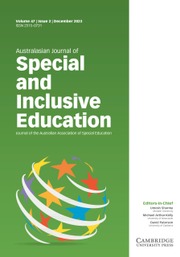Article contents
Using a Systematic Review to Explore Single-Subject Design Use Within Special Education Over Time
Published online by Cambridge University Press: 20 April 2020
Abstract
While teachers and researchers of students with disability are commonly interested in individual students and their progress towards individualised goals, traditional approaches to educational research that aim to illustrate generalisation between cause and effect are still commonly used. Traditional approaches, such as group-comparison designs, are used to demonstrate improved performance for the average student; however, they also obscure individual student data. Within special and inclusive education, single-subject designs may provide more appropriate conclusions to particular types of questions than traditional research methods as they allow for the examination of a functional relationship between the dependent and independent variables and rely on the participant serving as their own control. This article provides a summary of the use of single-subject designs within the field of special education over time and the findings of a systematic review conducted according to the PRISMA statement are presented. Through this systematic review, published articles from 7 prominent special education journals that involved intervention for school-aged students with disability were examined. In addition, a sample of exemplar studies that have employed single-subject designs are discussed.
Keywords
Information
- Type
- Original Articles
- Information
- Australasian Journal of Special and Inclusive Education , Volume 44 , Issue 1 , July 2020 , pp. 1 - 14
- Copyright
- © The Author(s) 2020
Footnotes
This manuscript was accepted under the Editorship of Michael Arthur-Kelly.
References
- 4
- Cited by

